Space
Can humans endure the psychological torment of living on Mars?
Published
1 month agoon


Can humans endure the psychological torment of living on Mars?
Alyssa Shannon is a registered nurse at UC Davis Medical Center. One day, on his way to the university hospital, NASA called him and told him that he had been selected for a mission to Mars. That same morning, Nathan Jones, an emergency room physician in Springfield, received a similar call. He immediately thought of his family and told himself that if you accept this opportunity, you will have to let them go. However, he couldn’t turn down NASA’s opportunity and convinced himself that Mars was his destiny.
The Mars Crew Health and Performance Probe Analogue Mission, or CHAPEA, will not actually send selected individuals to Mars, but rather will accurately simulate the first human journey to Mars and pave the way for sending the first humans to Mars, possibly by 2040. .
According to NASA, humans will one day travel to Mars. In 2018, NASA estimated that the first humans would land on Mars “by the late 2020s at the latest.” The date for the first human mission has changed slightly, but despite the technical hurdles, it will definitely happen one day. Rachel McCulley, until recently the deputy director of NASA’s Mars campaign, has compiled a list of 800 problems that must be solved before the first human mission can be launched.
Many of the items on the list are related to the mechanical problems of transporting people to a planet that never gets closer than 54.6 million kilometers to Earth. Keeping people alive in toxic soil and unbreathable air, bombarded by solar radiation and galactic cosmic rays, without access to immediate and safe communications to bring them back to Earth more than a year and a half later, are some of the challenges of a trip to Mars.
Other problems involve technical details that are too obscure for McCulley to explain. However, he has no doubt that NASA will overcome these challenges. Of course, what NASA and no one else knows yet is whether humanity can overcome the psychological torment of living on Mars.
CHAPEA’s mission addresses human rather than technical questions. For 378 days, four ordinary volunteers will experience the conditions of human life on Mars as much as possible. They received instructions, feedback, and full supervision from Mission Control. These people eat astronaut food, perform basic experiments, perform maintenance tasks, answer endless surveys, and enjoy organized downtime. This level of extreme realism is necessary to ensure that the experiment correctly determines whether humans can live millions of kilometers away from their acquaintances.
The experimenters wanted to know if the crew could eat astronaut food for hundreds of days without losing their appetite, weight, or positive attitude. Can they live in a confined space with strangers? Can they maintain a cohesive professional environment without contact with the ground? Such questions are of great importance because no mission to Mars can succeed if the inhabitants of Mars cannot maintain their health, happiness, and, most importantly, their sanity.
If Martians cannot maintain their mental health, no Mars mission will be successful
NASA’s goal of the simulated mission was to see if subjects could thrive in an environment designed to closely resemble Mars. NASA launched the program in August 2021 with a “Mars Calls” announcement on its website. Participation in CHAPEA, unlike most NASA missions, was open to the general public, or at least to a broad segment of the public: citizens or permanent residents between the ages of 30 and 55 with a master’s degree or higher in science, technology, engineering, and mathematics. Applicants were told that the experience was “mentally difficult”.
NASA offered four golden tickets to travel to a simulated settlement called Dune Alpha; The 158 square meter building was built inside a large warehouse at the Johnson Space Center in Houston. This settlement was built using 3D printing technology and instead of ink, Martian regolith was used. NASA did not have sufficient amounts of Martian regolith, so a special orange material called lavacrete was used, which was removed layer by layer from a 3D printer.
The residence has four identical cells that serve as bedrooms, a lounge, a television, and four chairs. There are also several desks with computer monitors, a medical station, and an agricultural garden in the settlement. Garden plants considered for mental health: Growing plants may have “psychological benefits for astronauts living in an isolated environment away from Earth,” says one researcher. The rooms have different heights to avoid the monotony of the space. The yard is shaped like a box filled with red sand and has two treadmills for the crew to practice “space walking”. The walls of the courtyard are covered with murals of Martian rocks and there are no windows.
The duration of the trial is the most obvious violation of the truth. Orbital geometry dictates that the shortest round-trip mission to Mars would take about 570 days, and this scenario might occur once every 15 years. A typical trip to Mars would take at least 800 days.
NASA has declined to disclose details of the 378-day confinement, which ends on July 6, 2024, to preserve the integrity of the experiment. NASA only emphasized that participants would experience “resource limitations, equipment failures, communication delays, and other environmental stressors.” For example, the crew on the Mars mission must form lasting emotional bonds with strangers and rely on each other for comfort. The crew must respond to any emergency situation on their own without any intervention or guidance. They must cope with not being able to care for a sick child, a grieving spouse, or a dying parent.
Future travelers to Mars must not only endure all these conditions alone, but also pursue this opportunity with a determined and honest purpose in order to earn the privilege of long-duration space travel. They must accept that for at least 570 days, they will be the most isolated humans in the history of the world.

How does isolation affect performance?
Alyssa Shannon had dreamed of Mars since she was a child and knew she could endure the hardships and long periods of isolation. Nathan Jones also felt that this mission was designed for him. But professional observers of America’s space programs, a group of NASA historians, ethicists, and advisers who spend much of their careers studying the future of space exploration, have raised the question: What does NASA want to learn from the CHAPEA mission that it doesn’t already know?
The psychological damage of social distancing is well understood. Everyone knows what isolation does to a person. Johnson Schwartz, a philosophy professor who studies the ethics of space exploration, says: “What ambiguity is left when you lock people in a room for a year? “Just because the room is painted to look like Mars doesn’t mean the results will change.”
Monotony prevents people from performing the most basic tasks
The sources of Johnson Schwartz’s talk are 80 years of study in the field of isolation. The study of isolation began in World War II. At the time, the British Royal Air Force was concerned about the performance of pilots during solo flights. The officers noticed that the longer the pilot stayed in the air, the fewer submarines he detected. Psychologist Norman McWorth also recognized that the monotony of the mission is to blame for this. The monotony of the mission made the pilots unable to perform even the most basic tasks.
The results of Mackworth’s study inspired a series of studies by psychologist Donald O. Hebb was from McGill University. Confirming McWorth’s findings, Hebb added new details. Monotony not only causes intellectual weakness, but also leads to “change in behavioral approach”. In Hebb’s experiment, his students slept and thought about their studies and personal problems. Then they would reminisce and recreate their movies or travels. Some also count to incredibly large numbers.
However all participants eventually lost the ability to focus. Several people also reported “blank periods” during which they thought about nothing. The next step was illusion. The hallucinations made people vulnerable, and long after the experiment was over, they believed the hallucinations were real.
Hebb’s findings inspired isolation studies. Individuals were confined in different locations and all results were consistent with each other. In addition to attracting neuroscientists and psychologists, the experiments also attracted the attention and funding of the US intelligence community. The findings were included in “forced counter-espionage interrogations” or what is now called “brainwashing” or “psychological torture”.
Isolation studies were also closely monitored by the Air Force, which led the fledgling US space program before NASA was formed in 1958. Concerned that spaceflight might drive astronauts crazy, the Air Force conducted the first test similar to CHAPEA. The astronauts in this experiment were confined for a week in the cockpit of the spaceship, which was slightly larger than a coffin. The pilots were assigned a large number of technical tasks and were given large quantities of amphetamines.
The experiment followed a familiar pattern: initial high spirits gave way to a “gradual increase in irritability” and suddenly turned to “open hostility.” Many participants experienced hallucinations, with one pilot even abandoning the test after three hours and seeking psychiatric care.
In all isolation experiments, initial high spirits eventually gave way to irritability, violence, and hallucinations.
Several other similar studies were conducted before all research was stopped by the Mercury Space Program. With the official start of the US space program in the early 1960s, astronauts during successful solo missions suffered no obvious psychological distress, much to the relief of researchers. All long-duration space travel took place in Earth orbit, and crews were easily able to communicate with Earth. Government agencies continued to investigate the effects of isolation, but NASA did not.
NASA didn’t have a solution to the problem of isolation in space, and it didn’t need to, until half a century later when a new challenge arose: a human mission to a planet so far away that it would take at least 22 minutes for a cry for help to travel through the solar system. slow
The delay in communication worried CHAPEA crew members and families. All contact with the settlement is timed by the time it takes to send the information from Earth to Mars. Even exchanging short sentences like “How are you? “Good” also lasts at least 44 minutes.
But “44 minutes” is considered the best possible case, since every connection must flow through a connection point. Any information unit must wait in a digital queue, with priority given to the most urgent signals and smallest data packets. As a result, any normal human conversation with the earth is unthinkable. Also, there will be no contact during a three-week period in the middle of the experiment that marks the furthest distance between Earth and Mars.

The selected CHAPEA crew respected NASA’s decision about the mission, but if they wanted to better imagine the year ahead, they should study an earlier series of Mars simulations that shared some goals with the CHAPEA mission. For example, the HI-SEAS Analog Space Mission and Space Exploration Simulator in Hawaii simulated trips to the Moon and Mars missions between 2013 and 2017.
Civilians on the HI-SEAS mission were selected to live in a habitat in Hawaii for 12 months. The mission investigated and studied various nutritional and “psychosocial” benefits, as well as volunteers’ behavior and mental alertness and coping strategies developed to resist isolation.
Once Upon a Time I Lived on Mars is the memoir of Keith Green, one of the original HI-SEAS crew, and includes chapters entitled “On Boredom”, “In Isolation” and “Dreams of Mars, Dreams of Earth”. Green explains how the monotony changed his mission. “At that time mental fatigue had become my main state of mind,” he writes. The crew barely slept, were under constant surveillance, and scheduled leisure seemed a little forced.” The slightest provocation drove Greene mad, and he soon found himself missing out on everyday life on Earth.
The HI-SEAS mission followed the Mars 500 mission , the longest Mars simulation mission ever. Mars500, operated by the Russian Institute of Biomedical Problems, put a six-man crew together on a synthetic Mars for 520 days, between June 2010 and November 2011, in a synthetic spacecraft and a synthetic landing module.
Russian experimenters hypothesized that over time, astronauts would lose motivation, work less, and suffer from feelings of extreme isolation. After the experiment was over, the scientists announced that the hypotheses were “largely confirmed.” Crews lost confidence in their commanders and mission control, communications became poorer, nutritional problems developed, and people became homesick and depressed. “It’s not easy to spend 520 days,” said Wang Yu , one of the participants who lost about 10 kilograms of weight and most of his hair. It is impossible to be happy all the time. “I am human, not a robot.”
Despite the previous results, the desire to simulate life on Mars still seems insatiable. CHAPEA is just one of dozens of NASA’s current analog experiments. One of Hera’s other missions is; A habitat that keeps four participants in isolation for 45 days. Since NASA ended participation in HI-SEAS, a variety of public and private organizations have continued the missions. The private association of the Mars community has been operating several research bases in the Utah desert and the remote islands of northern Canada for years. Analogues of Mars have also been performed in Dome C of the Antarctic Plateau, the semi-arid region of northeastern Brazil, ice caves in Austria and Oman.
The effect of selected isolation is not the same as imposed isolation
The first travelers to Mars are likely to have the same psychological profile as Shannon, Jones, and two other participants: Ross Brockwell, a structural engineer and director of general operations, and Kelly Heston, a stem cell biologist. All four are NASA enthusiasts and in perfect physical health and would welcome extended periods of isolation. These people themselves chose to spend a period of isolation and restriction.
Louise Hockley, an expert on social isolation, emphasizes that psychological responses are strongly influenced by whether isolation is chosen or imposed on individuals. A prisoner sentenced to life imprisonment usually suffers more than a monk who has taken a vow of silence. But Hockley points out that participants, no matter how well supported, are not autonomous. “Even if the crew is OK, what happens to the family that’s left behind?”
However, the designers of CHAPEA do not seem to have an understanding of the history of isolation and social isolation studies. In interviews, they also downplayed the findings of previous trials, including HI-SEAS. CHAPEA principal investigator Grace Douglas admitted she was “not entirely familiar” with the previous four-year trial, saying: “I don’t believe they met our performance criteria. “Our assessment is at a higher level of detail and will be more extensive.”
Rachel McCulley is NASA’s CHAPEA Funding Officer. When asked what he hopes to learn from the mission about human psychology, he said, “The big reason I funded the mission is because I want to know exactly how much food is needed for a Mars mission.”
But what about the psychological aspect of the mission? How do people cope with loneliness and monotony? McCulley is a solid fuel propulsion systems engineer and his goal was to determine the spacecraft’s weight. He could estimate the mass of everything, but he wanted to know how much food the four stressed astronauts would consume in 378 days and how much clothing they would need.
Investigating psychological issues is NASA’s second priority. Mathias, a historian of isolation, asks whether empirical logic can justify another study of isolation. In his opinion, these experiments are “a way to colonize Mars, or a form of wish fulfillment, or in other words, just cosplay.” Analog experiments reflect utopian promises about a future for humans on Mars. A human mission to Mars is not the highest ambition in space programs, but a small step for mankind before a giant leap in the habitation of other planets.
The inhabitants of Mars will turn from humans into a modified species of “Martians”.
Five months before the CHAPEA call, Dennis Bushnell, a 60-year senior scientist at NASA’s Langley Research Center, published a paper on the future of space exploration, commercialization, and habitation. He says colonizing Mars has always been conceivable for colonizing humans. He notes that the prospect has gone from “very difficult” to “increasingly feasible” in recent years.
Bushnell predicts that the Martian colonists will “become an altered species.” Travelers who colonize Mars will become Martians over time due to reduced exposure to heat and radiation. The ultimate promise of NASA’s Mars mission is a chance to start over, not exactly as humans, but as Martians. If we can settle on Mars and enjoy a carefree life with no regrets, it stands to reason that we should no longer be human, we should be Martians.
But Mathias likens the constant testing of Mars to a traumatic repetition. The compulsion to rebuild is an irrational and futile attempt to undo a deep injury. “The urge to try to recreate a perfect world is always repeating the same mistake we made here,” he says. “We are not looking for Mars, we are mourning for Earth.”
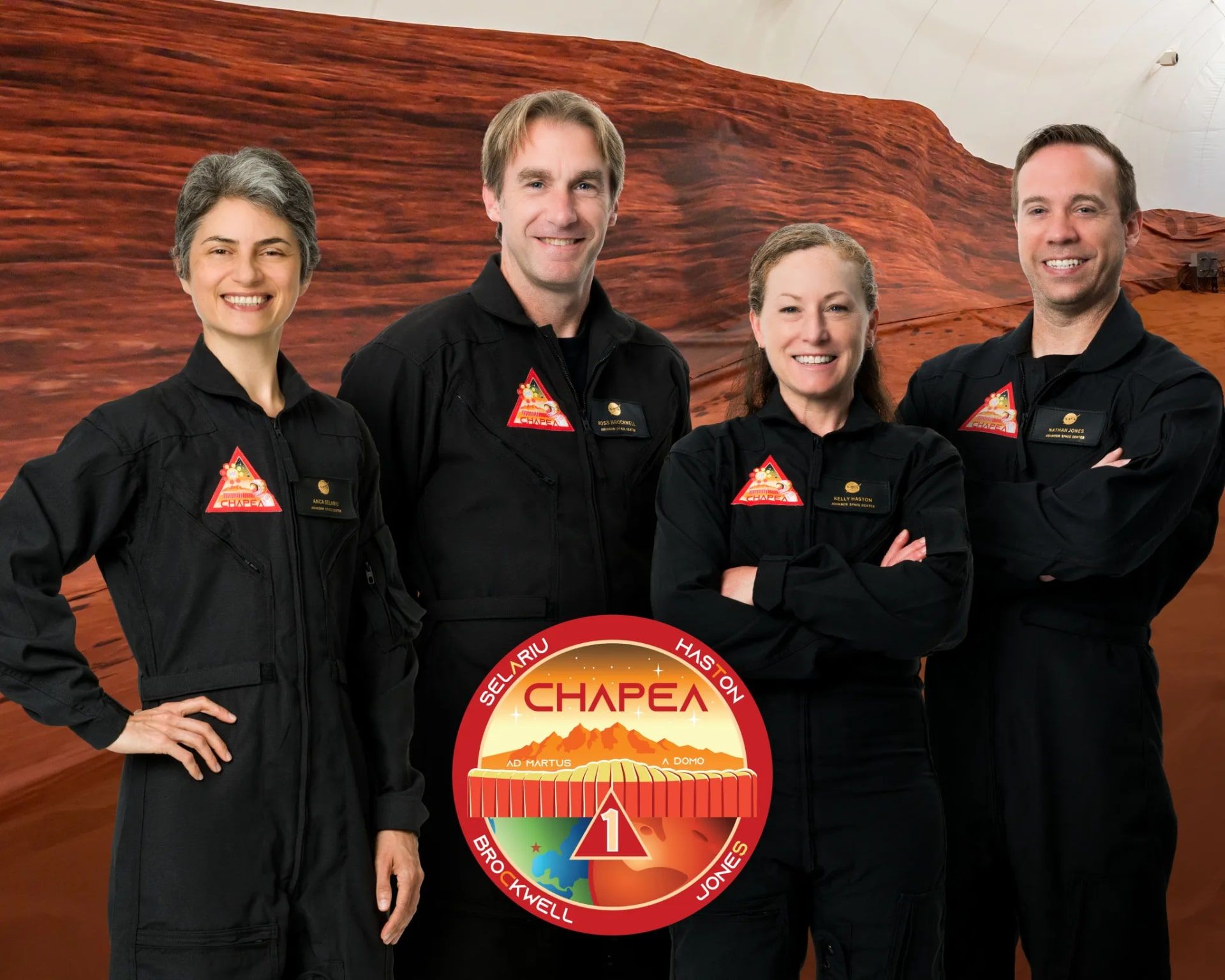 NASA released the official CHAPEA 1 crew portrait on June 25, 2023. From left to right: Anka Selario, Ross Brockwell, Kelly Heston, Nathan Jones.
NASA released the official CHAPEA 1 crew portrait on June 25, 2023. From left to right: Anka Selario, Ross Brockwell, Kelly Heston, Nathan Jones.
The four crew and two surrogates of the CHAPEA mission gathered together for a final month of training and evaluation a month before confinement to the settlement. Three weeks before arrival, NASA hosted a “Family Weekend” for the crew’s loved ones. Families visited the Johnson Space Center and interacted closely with the astronauts. The crew’s families agreed to share stress management techniques and pledged to keep in touch through a private Facebook page.
But Alyssa Shannon received a call five days before the mission began. He announced that NASA had removed him from the mission and had been replaced by U.S. Navy microbiologist Anka Selario. The reason for Alyssa’s removal was not released, but NASA investigators added that sometimes during final pre-mission tests, problems are found that are not “medically serious” but may pose a risk, such as an increased risk of kidney stones. Of course, this is just an example and the researchers refused to provide information.
On June 25, 2023, NASA’s YouTube channel broadcast footage of four CHAPEA 1 crew members standing on a platform in front of the settlement. Grace Douglas announced that the knowledge we gain here will help us send humans to Mars and return them home safely. Then, Douglas opened the simple white door of the settlement, the crew waved and entered. Douglas closed the door behind them. The happy voice of the crew could be heard from inside the settlement


You may like
-

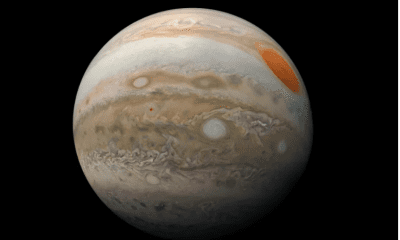


Why is Jupiter not a star due to its large size?
-

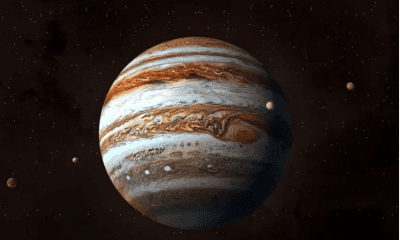


Why doesn’t Jupiter have big and bright rings like Saturn?
-

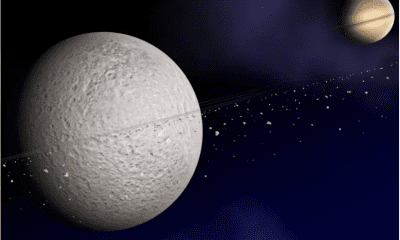


Why do none of the moons of the solar system have rings?
-

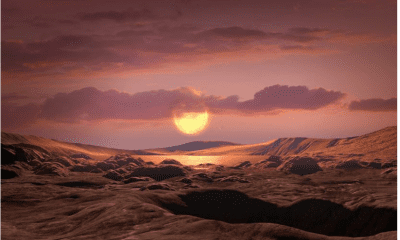


Most alien planets probably do not have day or night
-




The biography of Edwin Hubble
-

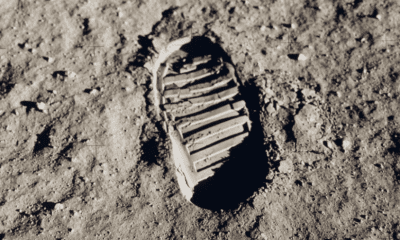


Can telescopes see astronaut footprints on the moon?


Why is Jupiter not a star due to its large size?
The smallest known main-sequence star in the Milky Way is a red dwarf called EBLM J0555-57Ab, located 600 light-years from Earth. With an average radius of nearly 59,000 kilometers, this star is only slightly larger than the planet Saturn. Therefore, this red dwarf is the smallest known star that has hydrogen fusion in its core; The process that provides the star’s energy to burn until the end of its life.
In the solar system, there are two objects bigger than the mentioned star. One of them is the sun; But the other is the planet Jupiter , whose radius reaches 69,911 kilometers; But why is Jupiter a planet and not a star according to these dimensions?
The answer to the above question is simple: Jupiter does not have enough mass to support the hydrogen-to-helium fusion process. The star EBLM J0555-57Ab is nearly 85 times more massive than Jupiter. If this star was a little lighter, it would not be able to perform the hydrogen fusion process; But if the solar system had a different structure, would it be possible for the planet Jupiter to shine as a star?
Jupiter and the Sun are more similar than you might think
Jupiter may not be a star, but it has a huge influence on the solar system. The mass of this gas giant is 2.5 times the total mass of other planets in the solar system. On the other hand, Jupiter has a low density of 1.33 grams per cubic centimeter. While the density of the Earth is close to 5.51 grams per cubic centimeter, which is four times more than the density of Jupiter.
But it is interesting to point out the similarities between Jupiter and the Sun. The density of the sun is 1.41 grams per cubic centimeter. These two crimes are also very similar in composition. In terms of mass, nearly 71% of the sun is made up of hydrogen and 21% of it is made up of helium, and traces of other elements can be seen in it. On the other hand, 73% of Jupiter is made of hydrogen and 24% of it is made of helium.

Illustration of the planet Jupiter and its moon Io
For the above reasons, Jupiter is sometimes called a failed star; But again, Jupiter is unlikely to even come close to being a star. Stars and planets form in two completely different mechanisms. Stars form when a dense knot of matter in an interstellar molecular cloud collapses under its own gravity. This material begins to rotate in a process called cloud collapse. As rotation continues, more material from the surrounding cloud enters the stellar accretion disk.
With the increase in mass and as a result of gravity, the core of the baby star becomes more and more compact, which causes the temperature to increase and make it hotter. Finally, this mass becomes so compressed and hot that its core ignites and the process of thermonuclear fusion begins.
Based on our understanding of the star formation process, when a star runs out of accretion material, a full portion of its accretion disk remains. Planets form from this residue. According to astronomers, for gas giants like Jupiter, this process, called accretion, begins with small clumps of icy rocks and dust in the disk. With the rotation of these materials around the baby star, their density starts gradually and they stick to each other with the force of static electricity. Finally, these growing masses reach the size of nearly 10 times the mass of the earth; So that they can gravitationally absorb more gases from the surrounding disk.
From this stage, the gradual growth of the customer and its current mass began. The current mass of Jupiter is 318 times the mass of the Earth and 0.001 times the mass of the Sun. When a gas giant absorbs all its available matter, its growth stops. As a result, Jupiter has never even approached the mass of a star. The reason why Jupiter’s composition is similar to the Sun is not that it is a failed star; Rather, the reason for being born in the molecular gas cloud is the same as the sun.
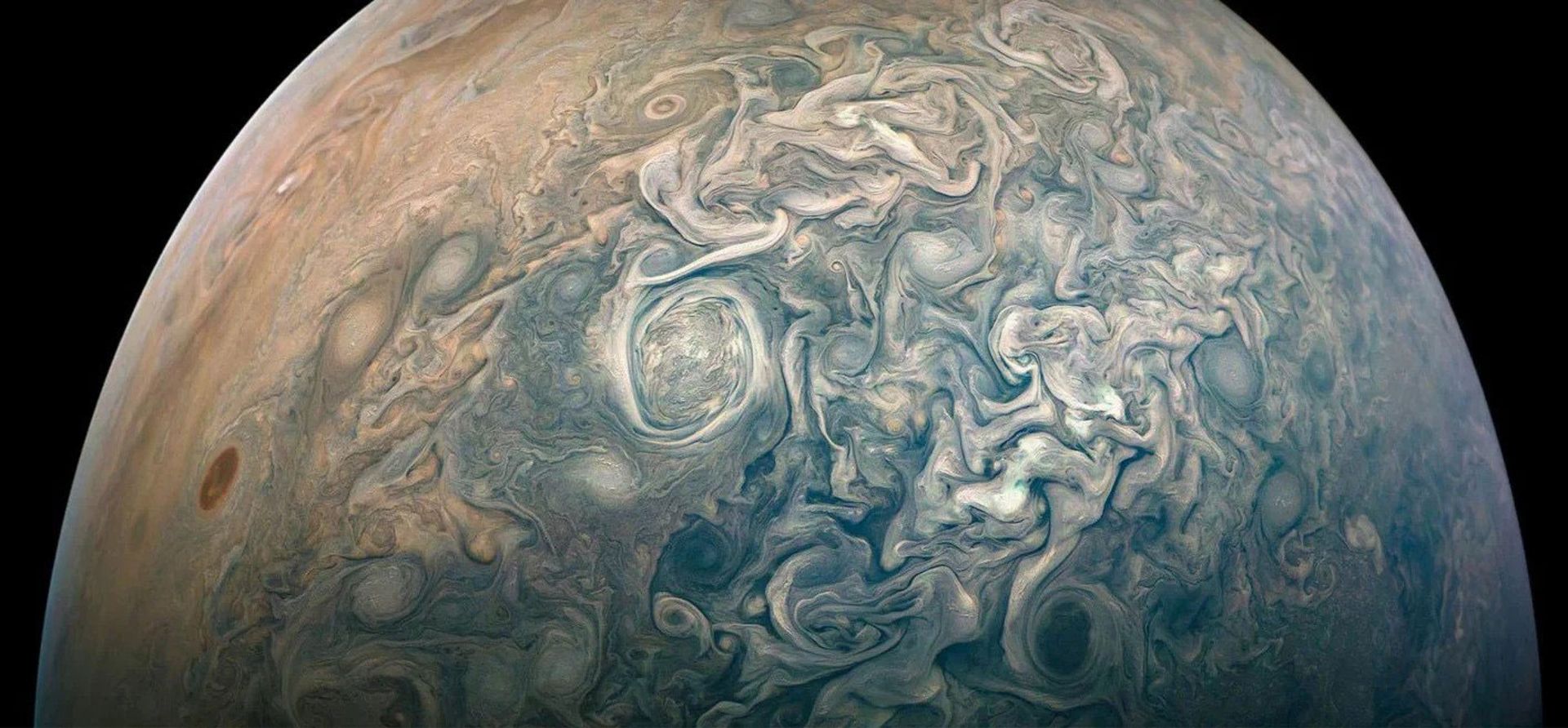
Real failed stars
There are different groups of objects that can be classified as failed stars. These objects are called brown dwarfs and can fill the gap between gas giants and stars. The mass of brown dwarfs starts at 13 times the mass of Jupiter. These objects are heavy enough to support nuclear fusion, but this fusion is not of ordinary hydrogen but of deuterium or heavy hydrogen. Deuterium is an isotope of hydrogen that has one proton and one neutron in its nucleus instead of just one proton. The temperature and pressure of deuterium fusion is lower than the temperature and pressure of hydrogen fusion.
Since deuterium fusion occurs at lower mass, temperature and pressure, it is one of the steps to reach hydrogen fusion for stars whose accretion process continues and absorb the surrounding mass; But some objects never reach the required mass for hydrogen fusion.
Shortly after the discovery of brown dwarfs in 1995, these objects were called failed stars or ambitious planets, but numerous studies show that the formation of these objects like stars was from cloud collapse, not core accumulation; Some brown dwarfs do not even have enough mass to fuse deuterium, making them difficult to distinguish from planets.
Jupiter has exactly the lower mass limit for cloud collapse; The minimum mass required for cloud collapse is approximately equal to the mass of the planet Jupiter. As a result, if the planet Jupiter was formed from the collapse of a cloud, we could place it in the group of failed stars; But data from NASA’s Juno probe suggests that Jupiter at least once had a solid core, which is more consistent with the theory of core formation.
Modeling shows that the upper limit of planetary mass and formation by core accretion method is less than 10 times the mass of Jupiter. As a result, the planet Jupiter is not included in the group of failed stars; But by thinking about the cause of this issue, we can get a better understanding of how the universe works. In addition, the planet Jupiter has a stormy, striped and twisted appearance, and the existence of humans would probably not be possible without this gas giant.
Space
Why doesn’t Jupiter have big and bright rings like Saturn?
Published
14 hours agoon
20/09/2024

Why doesn’t Jupiter have big and bright rings like Saturn?
Considering the similarity of the planet Jupiter to its neighbor Saturn, it is natural to ask why this planet does not have clear and bright rings like Saturn. However, Jupiter has thin, narrow rings made up of dust that only shine when there is sunlight in the background. According to new research, these narrow rings lack brightness because the large Galilean moons prevent rocks and dust from accumulating around Jupiter. According to Stephen Kane, an astrophysicist at the University of California Riverside:
The fact that Jupiter doesn’t have brighter rings than Saturn has bothered me for a long time. If Jupiter had such rings, it would certainly appear brighter to us because this planet is much closer to Earth than Saturn.
Keen and his colleague Zhixing Li, an astrophysicist at Riverside University, ran a series of simulations of objects orbiting Jupiter to test the hypothesis of a giant ring system around Jupiter at some point in history. The aforementioned simulations considered the orbital motion of Jupiter and its four largest moons, known as the Galilean moons, which are: Ganymede (which is even larger than Mercury and is known as the largest moon in the solar system), Callisto, Io, and Europa. The researchers also included enough time for the formation of a ring system in their simulations. According to this modeling, Jupiter has not even had rings similar to Saturn in the past and is unlikely to have them in the future. Kane explains:
Giant and heavy planets have heavy moons and these moons prevent the formation of rings of matter. The Galilean moons of Jupiter, one of the largest in the Solar System, would quickly destroy any potential large rings that might be forming.
Jupiter has narrow rings, most of which are dust from moons and material that may have been thrown into space by impact events. On the other hand, much of Saturn’s rings are made up of ice, possibly fragments of comets, asteroids, or icy moons that have been broken apart by Saturn’s gravity.
We know that Saturn’s moons play a vital role in the formation and maintenance of its rings, But one or more large moons can also gravitationally disrupt the rings and drive the ice out of the planetary orbit and into an unknown region. Although most people think that Saturn is the only planet with rings, rings around planets are very common even in the solar system. For example, in addition to Jupiter, the solar system’s ice giants Uranus and Neptune both have narrow rings of gas and dust.
Compared to other planets, Uranus has a strong axial deviation and its orbital axis is parallel to the orbital plane. The position of the rings of this planet is adjusted accordingly. Probably, a mass collided with Uranus and led to its axial deviation, or possibly this planet once had huge rings that caused this deviation. Of course, rings are not limited to planets. A small body with a width of 230 km called Chariklo, which is located in the orbit between Jupiter and Uranus, also has rings.
Also, the dwarf planet Haumea in the Kuiper belt has a ring. Simulations show that rings around ice masses are common due to the gravitational interaction and removal of ice from these masses.
Mars is also likely to be ringed in the future. The moon of Mars, Phobos, comes a little closer to this planet every year. Over the next hundred million years, the moon will come close enough to Mars that the planet’s gravity will break it apart, forming a short-lived ring that may recondense into a moon. Even Saturn’s rings may be temporary and rain down on the planet in the future. If we can study the rings in great detail, we can use them to fit together the puzzle pieces of planetary history. Kane believes:
To us astronomers, the rings are like bloodstains on a crime scene wall. When we look at the rings of the giant planets, we find evidence of the events that caused this material to accumulate.
Anyway, now that Jupiter has no spectacular rings, let’s enjoy Saturn’s rings. The Planetary Science Journal has accepted this research and is available on the arXiv database.


Why do none of the moons of the solar system have rings?
We have many strange moons in our solar system. hot and cold moons; Moons with liquids and dusty moons. One lunar planet is walnut-shaped and another is potato-shaped; But among almost 300 moons that have been discovered so far, not even one of them has rings. This is really strange.
Of the eight planets in the solar system, half have rings of dust and ice that orbit their equator. It is thought that Mars once had a ring, and according to new research, even our blue planet probably had a ring similar to Saturn’s ring about 500 million years ago, which lasted for tens of millions of years.
In addition, some dwarf planets also have rings; Although astronomers have not yet been able to understand how these rings are formed. Even some asteroids have their own rings.
While investigating the concept of ringed moons outside our solar system, Mario Socercchia, an astrophysicist at the Universidad Adolfo Ibánez in Chile, and his colleagues became involved in the question of why moons in our own cosmic neighborhood lack rings. In an interview with Science Alert, he explains:
If the giant planets of the solar system have rings, and if the asteroids beyond the orbit of Jupiter and the non-Neptunian bodies also have rings, why don’t the moons of the solar system have rings? This absence is illogical considering the presence of rings in other places. As a result, it is better to investigate whether there are underlying dynamical reasons that prevent the formation of rings or their long-term stability around moons.
 James Webb Space Telescope image of the rings of the planet Uranus.
James Webb Space Telescope image of the rings of the planet Uranus.
We have yet to definitively discover an extrasolar moon, but in 2021 Soserkia and his colleagues hypothesized that if a moon had a large ring system, it could engineer its existence by blocking enough starlight. But the group later realized that we have yet to see any ringed moons, so the likelihood of their existence is very low.
When you’re an astronomer with a question in mind and a simulation tool at hand, there’s only one thing you can do: build models of cosmic systems and see what happens when you set them in motion.
There are many raw materials from which rings can form around the moons of the solar system. Some of these materials are dust resulting from the formation of impact craters. Some other moons emit steam or gas of their own, so there seems to be no problem with ring formation.
Considering the gravitational influence of the moon, host planet and other moons, researchers designed and tested physical N simulations and realized that due to these variables, ring formation around moons is difficult.

For example, Saturn’s moon Enceladus releases water vapor, ice particles, and gases from its glaciers in the Antarctic region with its remarkable surface activity. However, instead of forming a ring around this moon, these materials are transported into Saturn’s orbit by strong interactions with neighboring moons, feeding Saturn’s E ring.
In other words, even though the moons produce part of the raw materials necessary for the ring, their surrounding environment makes a large part of these materials available to the host planet and prevents the formation of the ring around the moons themselves.
So far, NASA has discovered 293 moons in the orbit of the planets of the solar system, most of which belong to the planets Jupiter and Saturn. Also, moons around dwarf planets and even asteroids have been discovered.
Soserkia and his team simulated the moons of a variety of solar system objects, from the Earth’s moon to the larger moons of Jupiter and Saturn, over millions of years of evolution. They sought to investigate the stability of these objects, their gravitational environment, possible ring systems, and their changes over time. The results of the investigation were contrary to the expectations of the researchers. Susarkia explains about this:
At first I expected rings to be completely unstable, which directly answered our question. However, contrary to expectation, we found that these structures have maintained their stability in many conditions. Indeed, in a previous paper we showed that isolated moons can have stable rings, but we did not predict that moons would remain stable in harsh gravitational environments despite the large number of other moons and planets that have distributed their rings. Another surprise came when we realized that these harsh environments, instead of destroying the rings, beautified them by creating structures like cracks and waves, which were just like what we see in Saturn’s rings.
 Saturn’s moon Iapetus with its prominent equatorial ridge.
Saturn’s moon Iapetus with its prominent equatorial ridge.
Some features of the moons of the solar system are signs of the past of the rings. The simulations suggest that the pebbles found orbiting Saturn’s moon Rhea could be the last remnants of a complete ring system. Also, Saturn’s moon Iaptus has a equatorial groove, which could be the remnant of a ring that fell on this moon, and in this sense, it is just like Saturn’s rings that slowly fall on this gas giant.
The findings show that the reason we do not see rings in the solar system today is that we are not in the right time and place. Solar radiation pressure, magnetic fields, internal heating, and magnetospheric plasma all contribute to the loss of once-existing lunar rings. According to Susarkia:
I believe we are unlucky to some extent; Because we started observing the universe during a period when these structures no longer exist. After doing this research, I was convinced that these rings probably existed in the past.
On the other hand, the only reason we see Saturn’s rings is because we are in the right place and time. For this reason, we see solar and lunar eclipses; Because the moon is gradually moving away from the earth and at some point it will be so far that it can no longer completely cover the sun.
 The glory of Saturn’s rings.
The glory of Saturn’s rings.
The researchers believe that further simulations that take into account more parameters, such as beam pressure and magnetic fields, can help us understand the absence of lunar rings in more detail. We should also look more closely at the moons and look for evidence of the past, such as the craters on Iaptus.
At the same time, Suserkia and his colleagues are looking to expand their search and look for moons of rings around alien extrasolar worlds. He explains:
I wonder what mythical and epic stories we will hear from the inhabitants of other worlds about ringed moons. I mean, how will their stories and culture about the moons of the rings be different from our stories? There are infinite possibilities.
The scientists’ research has been accepted for publication in the Journal of Astronomy and Astrophysics and is available in the archive database.


Why is Jupiter not a star due to its large size?


Why doesn’t Jupiter have big and bright rings like Saturn?


Why do none of the moons of the solar system have rings?


The biography of Andy Rubin, the creator of Android


How to prevent your location from being revealed through photos?


How to use iMessage on Android?


Xiaomi Glorimi M2 Max watch review; Alternative economic option for iPhone owners


Ten strange moons of the solar system


Why do we humans sleep?


What is the difference between the brain of athletes and the brain of normal people?
Popular
-



 Technology1 year ago
Technology1 year agoWho has checked our Whatsapp profile viewed my Whatsapp August 2023
-



 Technology1 year ago
Technology1 year agoSecond WhatsApp , how to install and download dual WhatsApp August 2023
-



 Technology1 year ago
Technology1 year agoHow to use ChatGPT on Android and iOS
-



 AI2 years ago
AI2 years agoUber replaces human drivers with robots
-



 Technology1 year ago
Technology1 year agoThe best Android tablets 2023, buying guide
-



 Technology1 year ago
Technology1 year agoThe best photography cameras 2023, buying guide and price
-



 Humans2 years ago
Humans2 years agoCell Rover analyzes the inside of cells without destroying them
-



 Technology1 year ago
Technology1 year agoHow to prevent automatic download of applications on Samsung phones
